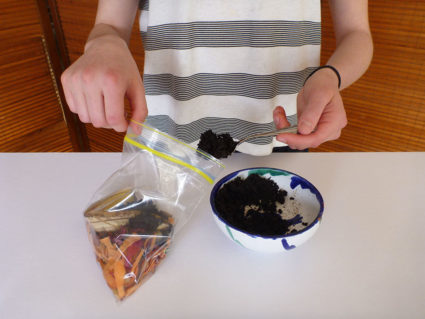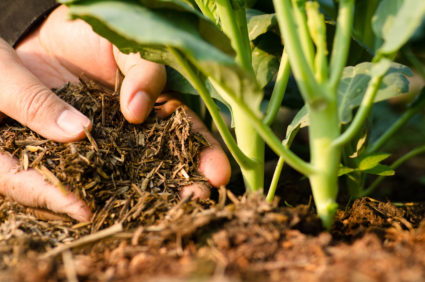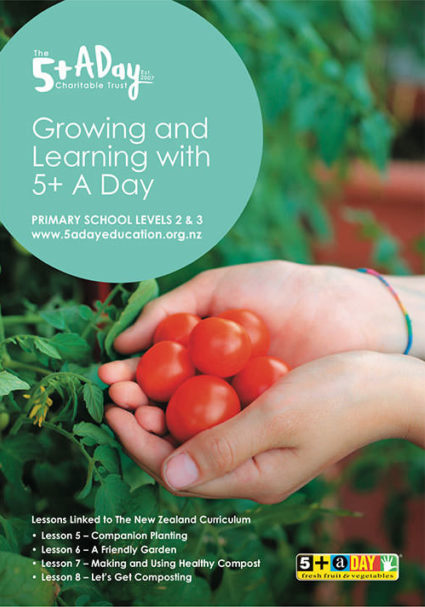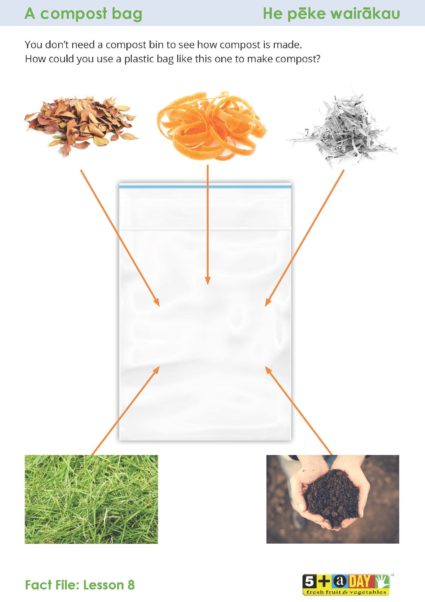Primary
Lesson 8: Let’s Get Composting!
In this practical lesson, students will use what they have learned in Lesson 7 to create compost. They can watch and record the changes that occur.


This lesson is featured in our printed resource; Book 2: Growing and Learning with 5+ A Day, Levels 2 & 3.
Order the print version here or download here to print yourself.
Learning Intentions

Students will:
- learn that the composting process occurs over a period of time
- learn that the composting process relies on the correct environment and action of fungi, bacteria, and invertebrates to create nutrient-rich humus.
Possible Achievement Objectives
Science: Level 2
PROPERTIES AND CHANGES OF MATTER
Students will :
- observe, describe, and compare physical and chemical properties of common materials and changes, which occur when materials are mixed, heated, or cooled.
Mathematics and Statistics: Level 3
PATTERNS AND RELATIONSHIPS
Students will:
- connect members of sequential patterns with their ordinal position and use tables, graphs, and diagrams to find relationships between successive elements of number and spatial patterns.
Preparation
What You Need
- eBook: Fredge’s Compost
- Fact File: A compost bag/He pēke wairākau
- Plastic zip-lock bags (1 per student)
- Accurate kitchen scales
- Garden soil
- Material to compost, e.g., fruit and vegetable peelings, grass clippings, torn newspaper, dry leaves
- Photo Card: Inside the compost bag/Kei roto i te pēke wairākau
- Resource Sheet: Dynamic debris/Kōkīkī hihiri
Additional Resources
- Extraordinary Earthworms, by Sean O’Connor, Ready to Read, Gold 2
https://tinyurl.com/gum7e6s - Dig In, by Bronwen Wall, Junior Journal 52
https://tinyurl.com/hj7goqu
Key Vocabulary
Unfamiliar concepts and vocabulary should be used and defined in context:
bacteria/huakita: tiny organisms that help with breaking down living things; You need a microscope to see them
fungi/hekaheka: helps to decompose, or break down, plant, animal, and other living matter; mushrooms and mould are fungi
Learning Opportunity
This lesson will allow students to set up an experiment to observe the composting process and to record the visible changes and the falling weight of each sample as the water leaves the materials.
The Lesson
eBook: Fredge’s Compost
Begin the lesson by revisiting the eBook, Fredge’s Compost (click on the cover of the eBook). There is audio for this story that you can use, or students can take turns to read the text.
The focus of the eBook is to reinforce information about correct composting and the value of composting for soil health. For information on using 5+ A Day eBooks, click here.
There are two interactive activities that follow the eBook. They work on a computer, a tablet, or an IWB. They can be used during or at the end of the lesson or in choosing time to reinforce key information from the story. Students will get the most from these activities if you model them first and explain the actions required and the aims of the activity. Then students can do them independently or in pairs.
For Activity 7, help Fredge make compost by dragging the correct materials to create good compost into the compost bin: banana, apple, carrot, spinach. For Activity 8, to show the steps in the creation of healthy compost, drag the items into the compost bin in the correct order: food scraps, rotting food, compost creatures, compost.
After revisiting the eBook, ask the students if they can remember the steps from collecting food scraps to compost that is ready for the garden. You could copy the text of each step from the book onto separate cards and have the students arrange them in the correct order:
- Every day, Fredge and the HQ team fed the compost bin.
- The food scraps, grass, and leaves mingled and began to rot.
- Beetles, worms, and centipedes crawled in for a feed.
- Bacteria and fungi also ate the scraps, helping to break them down.
- The bin became a dark, warm place, and over time compost formed.
Fact File: A compost bag/He pēke wairākau
Explain to the students that they are going to make compost in the classroom and watch how it changes.
- How could we do this? What could we use instead of a compost bin?/Me pēwhea tātou e mahi ai? Me whakamahi tātou i te aha, inā kāore he ipu wairākau?
Show the students the Fact File: A compost bag/He pēke wairākau (click on the image to enlarge, download, and print). You can enlarge this using a data projector or use printouts and share these in small groups.
- What does this tell us to do?/Mai i tēnei, he aha ngā tohutohu mo tātou?
Discuss the materials and the sealable plastic bag. Then show the students the groups of materials they can use to start their own compost bags. (Students can collect some of these materials in the week before the lesson. They only need a small amount of each.)
Note: Don’t let the students touch or sniff the compost as it is in progress. Some of the bacteria can cause Legionnaires’ Disease, which is a pneumonia caused by bacteria commonly found in water and soils, including potting mix and compost. The students should always open the compost bags in a well-ventilated area, preferably outdoors, and away from their faces. They should wash their hands after they opened and resealed their compost bags.
Making a compost bag
Show the students the steps they need to follow in their experiment and discuss them. Click here to download and print out the step-by-step Making a compost bag.
Photo Card: Inside the compost bag/Kei roto i te pēke wairākau
Share the Photo Card: Inside the compost bag/Kei roto i te pēke wairākau (click on the image to enlarge, download, and print), and think about why the weight of the bag changes over time.
Reflect on the Learning
Revisit the "Making a compost bag" steps each day when students shake or massage their compost bags. They can observe what’s happening to the compost in their compost bags over a six-week period, and use the Resource Sheet: Dynamic debris/Kōkīkī hihiri (click on the image to enlarge, download, and print) to record their observations and complete the graph. After 6 weeks, they can compare and discuss their observations and the graphs they have drawn from the data they collected.
Reflect on the experiences and learning from the lesson. You can also revisit and discuss the learning intentions:
- the composting process occurs over a period of time
- the composting process relies on the correct environment and the action of fungi, bacteria, and invertebrates to create nutrient-rich humus.




